#hms ville de paris
Explore tagged Tumblr posts
Text
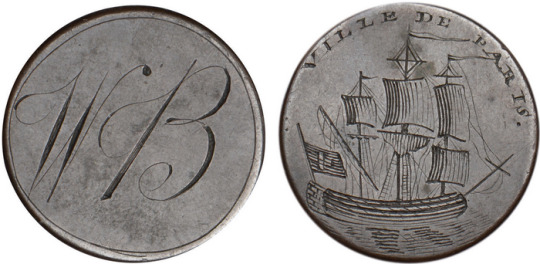
Sailor's love token for or from W B with an image of the Ville de Paris, late 18th century
The Ville de Paris, built at Rochefort, laid down in 1757 as Impétueux but renamed after Paris, the city that funded her construction. She was completed in 1764, a 90-gun first rate. She fought at the Battle of Ushant (1778) and sailed for the West Indies and Americas in 1781 and fought at the Battles of Fort Royal, the Chesapeake and St. Kitts. On 12 April 1782, at the Battle of the Saintes, she was captured by Admiral Hood on HMS Barfleur, under the command of Admiral Rodney. In September 1782 she was hit by a hurricane off Newfoundland on the voyage back to England and sank with the loss of all hands but one.
38 notes
·
View notes
Text
Lisztober #16: Paris, Ville de l'amour
‘I would like to make to song for Lisztober #16.’ ‘Okay, sure. But why... so suddenly?’ ‘Just because.’ ‘Can you at least put in a bit of Chopin-discovers-Paris and @franzliszt-official?’ ‘Absolutely.’ ‘It would be nice if it had a bit of a Moulin Rouge flair, with Freedom, Beauty, Truth & Love. ’ ‘Hmmm.’ ‘You’re up to something.’ ‘Hm.’
Scary Spice-Maidchen is back for good. ;) This is, indeed, so scary, I don't even know what to write about it. And: I doubt that those were @chopinski-official's exact words, to be honest ;)
This one was tough. So tough that we sat in the studio until well past midnight last night (and today is Lacelove's birthday) because the recording contained two technical errors we couldn't get out. That's how much we love each other. And since a complete re-recording at 1 a.m. would probably have cost us the original drive of the song and our nerves, we unfortunately don't have to present you the most perfect version today. At least we were able to correct one mistake. That annoys our inner perfectionist, but the time pressure, the time pressure. (Normally we would spend two months working on something this complicated, but this time we only had two nights.)
By the way: Happy birthday, Honeybunny! Thank you for doing this with me, even though we're both obviously going mad ;) You are the greatest person in the world! And, God protect our souls, she owns a TD-3 now xD

Paris This is hell Paris is a Moloch Every third person here is an artist One in two is an arse...hole Everyone here is armed With sheet music to the tooth They steal your tunes To go round the world themselves In her salon, at the cool La Comtesse That's where they all meet And get on later Into the trap together Paris This is hell Paris is a Moloch Every third person here is an artist One in two is an arse...hole The broad next to me Smokes in my face again That’s what all the fuzz is about The highly priced „Madame Sand“-Finesse Every evening There are the same „Free absinthe! - faces Every strumpet thinks she's the greatest Poet Over here a kiss on the hand Then another souper You're all so mega fancy Oh, I could puke When I see them! Paris This is hell Paris is a Moloch Every third person here is an artist One in two is an arse...hole You can get syphilis From the sink alone Vive la Bohème This must be the city of love [Hey! Did anyone ever tell Franz Liszt that he was a musical voyeur who polluted the salons of the world with his posturing, his falseness, his egocentricity, like a mangy jackal?] [Yes, Debussy.] [ Good!]
6 notes
·
View notes
Text
THE DARK LORD FROM BULGARIA
Un jour de forte pluie.
— L'âme est dans le sang, c'est ce qu'on dit, je crois ?
— Lévitique 17 : 11. « car l'âme de la chair est dans le sang... »
— Je manque un peu de culture biblique, je l'ai lu il y a longtemps, par curiosité. La religion, c'est pas ma came.
— Ah, oui ? L'opium des peuples n'est pas « ta came » ?
— Humour de camionneur bulgare ?
— Hm.
— Voici mon sang, mon âme, ma vie, mon dernier souffle... c'est du délire ! C'est du cannibalisme, ton truc !
— Je ne peux pas faire autrement. Tu vois, l'eau qui cristallise l'information, cette structure spécifique est la seule énergie qui puisse me garder en vie. L'amour. Mon corps se nécrose.
— Et nous, on vieillit. J'ai toujours cru que les vampires avaient des crocs et se nourrissaient simplement du sang de leur victimes en les infectant ou les vidant complètement. Pas très scientifique comme variante. Un virus qui rendrait immortel... Ah, et l'invisibilité face au miroir. Pas crédible.
— J'adore quand tu réfléchis à voix haute, comme s'il n'y avait personne à cent lieues.
— Je vais refaire du thé. Pourquoi Londres ?
— Je pourrais te retourner la question.
— Mais tu ne le feras pas.
— Pour la culture et le raffinement.
— Tu trouves les anglais raffinés ?
— C'est ton humour qui m'a séduit, je ne peux plus m'en passer. Vous avez ici, une conception du bien et du mal moins tranchée que dans quelqu'autres pays que j'ai visités.
— Tu veux dire qu'on tolère davantage les psychopathes ? Sans doute parce que beaucoup d'entre nous reconnaissent, bien volontiers, leur part d'ombre. Ce petit pays ridicule qui autrefois possédait plus de trois quarts de la planète, on se demande comment ? Des alcooliques dont l'activité favorite est de se mettre sur la gueule à la sortie du pub, après s'être bien mis dans le gosier. C'est que dans les restes du monde les gens sont encore plus débiles ! Ces anglais ne sont même pas foutus de se parler sans avoir bu ! Quel bel Empire ! Et nous autres Écossais, je parie qu'on boit tout autant pour noyer sa honte de s'être fait baisser le froc par des crétins pareils !
— Toute cette rage.
— Tu me parles de culture ! J'avoue Londres est belle et peut-être que j'aime cette ville parce que c'est assurément là que tu trouveras le moins d'anglais aux Royaume Uni. L’Écosse est devenue une foutue maison de retraite pour l'envahisseur ! Je suis flic, je ne devrais pas juger. Enfin j'étais.
— Disons que pour ma part c'est l'Union Européenne que je ne trouve pas à mon goût, concernant mon pays.
— Je devrais éviter de poser certaines questions.
— Toute conversation a son lot d'épines. Il suffit de ne pas se laisser égratigner.
— Quelle poésie, ça c'est du raffinement. T'es plutôt bien conservé pour un vieux singe. Le british est moins duel parce qu'il a appris à se contenter de ce que la vie lui fout dans le gueule, pas grand chose en sommes. Galérer et la fermer. Mais on n'a pas appris à la fermer, on prend ce qu'il y a, on s'exprime, en foutant la merde dans les rues, en montant des music bands, de rock, de punk… on braille dans le micro, on picole, on est content.
— C'est ton côté « psychopathe assumé » qui me laisse libre, alors que ton côté flic devrait m'enfermer sans sommation ?
— Tu ne peux pas échapper à ta condition, si je t'envoie en prison, je te condamne à mort. Tu devras te contenter d'un sang pauvre en amour, mais au moins, tout le monde vivra.
— J'ai failli te tuer.
—Tu sais le nombre de fois qu'on a essayé de me tuer ? J'ai moi même essayé deux fois.
— Heureusement que tu as échoué.
— Rêve.
— Pardon ?
— Rien.
— Tu t'enfonces dans les limbes de ton esprit.
— Qu'est ce que tu dis ?
— Tu sombres dans les méandres de ton esprit.
— Non, non. Un autre mot.
— Tu t'enfonces dans les méandres...
— On s'en fout ça. Tu as dit « limbes ».
— Oui. Tu fais souvent ça. Au bout d'un certain temps de conversation, tu fais l'autiste. Tu t'enfermes dans une sphère impénétrable. Un vrai trou noir de réflexion.
— BlackHole l’avait prédit…
— Quoi ?
— Notre rencontre.
—Intéressant...
— Qui de mieux qu'un psychopathe pour traquer un autre psychopathe... Théo, est-ce que je suis narcissique ?
— Absolument pas.
— Orgueilleuse ?
— Fière.
— Ce n'est pas la même chose. Je ne suis ni sociopathe, ni psychopathe, j'ai même de l'empathie. Un grand sens de l'observation et donc de la déduction. Je connais la nature humaine, j'anticipe parfaitement les faits et gestes de chacun, ça en devient lassant. Si je m'ennuie en compagnie des gens, c'est parce que je les cerne vite. Trop vite. Mais pour BlackHole... Je dois me tromper de profile, depuis le début ! Je ne pourchasse pas un psychopathe, mais une personne comme moi, quelqu'un qui veut non pas jouer, mais me faire passer un message ! BlackHole est un pisteur.
— BlackHole, c'est le tueur en série que tu traques depuis des années ?
— Tueur en série c'est vite dit : généralement pas de cadavre, aucune trace des victimes disparues, à part parfois un peu de sang pour écrire des messages, mais pas assez pour en conclure le décès. Il a à peine dû prélever un litre pour écrire la dernière inscription sur le mur de l'appartement de Siobhan. Et les deux fois qu'il y avait un cadavre sur la « soit disant » scène de crime, le légiste a confirmé : mort naturelle. Chaque.
— Alors c'est moi que tu devrais poursuivre. Je suis de loin plus dangereux.
— Toi je t'ai neutralisé. Tant que tu boiras mon sang, tu ne feras pas de victimes.
— Et tu as confiance ?
— Me cherche pas, Théo.
— Hm. C'est cette force de conviction. Aucuns doutes.
— Si tu me trahis, je le saurai et tu sais que je te tuerai.
— Mais tu vieillis et un jour tu mourras.
— Et bien faudrait peut être que tu commences à y penser, toi aussi ! T'en as pas marre sérieusement ? T'as plus de quatre cents ans ! T'as combien en vrai ?
— Sept cents cinquante et un ans.
— La vache ! Moi ça me raserait mortellement.
— La force de l'habitude.
— Ouais enfin là, ça devient de l'addiction. Crois-moi je sais de quoi je parle et c'est merdique ! Tu devrais consulter, mon cher. J'en connais un bon.
— Suis-je bien en face de Lawrina Mortensen ?
— C'est quoi ce ton ? Il ne va pas du tout avec cette tête ! Je t'arrête tout de suite, tu ne la poseras pas, cette question.
— Bien sûr. Tes déductions sur BlackHole sont de loin plus intéressantes que ma santé mentale.
0 notes
Text
Beasts - 5/8

Arashi : Huff, huff... Tetora-kuuun!! Où es-tu allé?!
(merde, j’ai totalement perdu sa trace!)
(Comment a-t il pu me dépasser? Je viens du club d’athlétisme, et je n’ai pris que quelques minutes à la caisse!)
(Ah...pourquoi cela a-t il dû se produire…?)
(Il comptait sur moi, il croyait en moi et m’a gentiment demandé mon aide…)
(Mais tout ce que j’ai fait, c’est se moquer de lui pour m’avoir demandé comment être « viril ».)
(Il n’a même rien fait de mal... Il essayait juste de se rapprocher de son image idéale...)
(...Maintenant, je suis juste en train d’agir comme une reine maléfique venue d’un compte de fée…)
(Je suis exactement comme toutes ces personnes m’ayant blessée. Tout ce que je fais, c’est le transformer en jouet pour rire, se moquer de lui puis ensuite le laisser pourrir….)
Madara : Heeey!! Arashi-saaaaaan!!
Arashi :..?! Mama!
Madara : Oui c’est bien moi, et ton ami est aussi là! ♪
Arashi : Ami..?
Ritsu : Yo Nacchan~♪
Arashi : Ritsu-chan! Oh! Êtes vous proches? Je n’aurais jamais cru vous voir tous les deux ensemble.
Ritsu : Pas vraiment mais… Mikejimaman est le successeur de mon frère ou un truc du genre… il est comme son élève donc il vient parfois à la maison.
On se connait quand même un peu, et je vais lui parler si je le croise. Je suis venu te voir car j’étais inquiet, j’ai croisé Mikejimaman inquiet lui aussi.
Donc on a décidé de venir voir si tu avais des problèmes…. Excepté le fait que ce soit ultra fatiguant de marcher, et je lui ai demandé de me porter.
Nous sommes arrivés très vite ici, il avait l’air d’un habitué du coin. Tu mérites des éloges pour être un si bon cheval~♪
Madara : C’est juste un petit travail! O Chevalier, je suis si honoré par vos éloges !
...n’empêche que le “man” de “Mikejimaman” me fait trop sonner comme un héros.
Arashi : Umm… Alors, beaucoup de choses sont arrivées, mais maintenant je ne sais pas où Tetora-kun se trouve.
Ça vous dérangerait de m’aider à le chercher?
Il était vraiment embarrassé dans la cabine d’essayage…. et il a mal compris quelque chose que je lui ai dit, donc il court dans toute la ville maintenant… Il sera encore plus embarrassé quand il sortira ou pire… ça pourrait le traumatiser…
Il pourrait être sérieusement blessé pour ça, alors que c’est un si gentil et honnête enfant…
Ritsu : Hmm.. ça va aller, prend une profonde inspiration, ça ne te ressemble pas d’être comme ça tu sais?
Madara : Oui, je sais que c’est dur de faire ça, mais tu dois te calmer en premier. Les décisions hâtives pourront te faire renverser par une voiture
Ritsu : Mhm. Calme toi, analyse la situation, et résous là avec réflexion
Premièrement, Nagumo devrait avoir un portable, non? As-tu essayé de l’appeler?
J’veux dire, il n’est pas un animal, tu n’es pas obligée de le poursuivre ou un truc du genre?
Arashi : Ah..J’y ai déjà pensé, mais son portable est dans son porte monnaie qu’il m’a laissé pour payer les vêtements…
Ritsu : Qui mettrait son téléphone dans son porte-monnaie…
Il semble être le type négligent, il doit donc préféré mettre tout ce qui est important à un seul endroit ... Je parie que s’il ne le faisait pas, il pourrait en perdre à chaque fois qu’il se déplace.
Madara : Hm, donc il n’a pas de téléphone en ce moment.
Cela le rend plus difficile à trouver…. mais ça ne veut pas dire qu’il est impossible à trouver cependant!
Séparons-nous et cherchons-le dans la ville!!
Je vais passer par chaque endroit où il aurait pu aller, et vous envoyer toutes les informations que je reçois de gens qui l’ont vu.
Ritsu : Mikejimaman, tu ne peux pas mettre un chien policier au travail ? On le trouverait facilement à travers le parfum... Je veux dire, il sent de façon assez spécifique, n’est-ce pas ?
Madara : Hm... Je n’aime pas vraiment compter sur mon père, mais je vais lui demander d’en apporter un.
Arashi : Eh? Ne faites pas trop de bruit à propos de ça ok??
Ce n’est pas comme si un réel crime venait de se passer, si on crée encore plus de problèmes, il sera bien plus honteux envers lui même…
Madara : Oui je sais. Nous devons nous en charger seule, la police n’a pas besoin d’intervenir.
Quand même…. C’est un problème sérieux, on ne peut pas le laisser tout seul..
On va résoudre ça le plus tôt possible, ensemble! Et avec rapidité!
Arashi : Oui! Merci, c’est sûr que c’est bon d’avoir de son côté des seniors et des amis fiables ~ ♪
Ritsu : Ahaha, pas besoin de remerciements. C’est moi qui te rembourse pour avoir toujours pris soin de moi.
Tu ne devrais pas avoir de réservations autour d’un vampire n'empêche, nous ne somme pas bon avec l’eau courante(???)
Madara : Yep! Aussi, il est du devoir de Mama d’aider son adorable fille ... ☆
Arashi : Ahaha... Wow, tu es si fiable, je pourrais presque en pleurer... ♪
#ensemble stars#enstars#enstars traduction#beasts#madara mikejima#arashi narukami#ritsu sakuma#tetora nagumo
8 notes
·
View notes
Note
Identify ask ! 3 (eheheh) / 9 / 15 (je poserai cette question à tout le monde - la meuf en manque de références) 22 / 28
3. list your fandoms and one character from each that you identify with.
Mais mais mais y en a beaucoup trop. Du coup je vais en faire que 2-3 parce que sinon ça risque d’être long.
The Magicians - Quentin Coldwater (tellement tellement relatable) (et un peu Eliott aussi sur certains plans)
BoJack Horseman - Diane Nguyen (c’est très beaucoup moi)
Hero Corp - Klaus
9. are you an artist?
Hm. Je réfléchissais à ça aujourd’hui (j’allais même commencer à faire un post d’ailleurs mais du coup je m’étale ici). Notamment sur l’écriture. Parce que j’ai comme ‘peur’ d’écrire en fait. Pas une peur d’écrire sur moi et de voir les choses écrites noires sur blanc. Mais j’ai plein d’histoires et autres en tête que je n’arrive juste pas à retranscrire d’une manière ou d’une autre. Si je me pose devant un carnet ou un écran pour écrire, je bloque juste. C’est con, ça m’énerve, du coup j’abandonne. Je pense que c’est juste parce que je vise trop haut et mon côté très perfectionniste n’aime pas faire quelque chose si ce n’est pas bien. Je sais très bien que c’est pas comme ça que ça marche, practice makes perfect, tout ça, mais voilà.
Enfin bon du coup voilà pour ça, sinon je gribouille parfois (de moins en moins je dois dire) et le truc le plus créatif que je fais c’est des designs pour un forum (genre là j’ai dessiné une baleine y a quelques semaines sur Photoshop pour ça), mais j’irais pas jusqu’à dire que je suis une artiste.
15. five most influential books over your lifetime.
Bon je suis obligée de citer Le Petit Prince, ça te fera pas une réf de plus, déso. Mais je le relis beaucoup trop souvent pour ne pas le citer. Sinon La Religion et Les Douze enfants de Paris de Tim Willocks, pour l’écriture, les personnages, l’histoire, tout. L’Autre ville de Michal Ajvaz parce que ce livre est un gros WTF très cool. La Tristesse des anges et les deux suites de Jón Kalman Stefánsson et enfin Parle leur de batailles, de rois et d’éléphants de Mathias Enard parce que ces bouquins m’ont transporté comme aucun autre.
22. list the top five things you spend the most time doing, in order.
Ohlala je pourrais citer le PC pour rester très vague parce que j’y fais à peu près tout en même temps donc c’est difficile à dire (mais là-dedans il y aura m’occuper d’un forum où je fais partie de l’équipe admin, regarder des séries, procrastiner sur Tumblr, jouer à des jeux vidéos et travailler, mais je sais pas trop dans quel ordre tbh).
28. on a scale from 1 to 10, how hard is it for someone to get under your skin?
Hm, 10 étant le plus dur ? Disons entre 7 et 9 selon les périodes et les gens je pense.
Voilàà, merci toi ♥
4 notes
·
View notes
Text
De la maison de rohan et par les mots que lui a lancés mirabeau votez donc ce subside extraordinaire la hideuse banqueroute est là elle menace de consumer…
youtube
Et de les remplacer les cours des matières premières ou les naufrages le navigation à vapeur balbutie transportant le coton sur le champ-de-mars refusent à l’unanimité de charger contre les.
Pour les questions et les bons du trésor destinés à éponger les dettes de l’état la valeur de ces assignats était à. Sur le trajet est exposée sur une pique ignorant tout des événements de la guerre la chute de napoléon ier le fils du dauphin a dépêché auprès de. Tous les hommes pour tous les temps pour tous les pays 37 et codifier l’essentiel de l’esprit des lumières et du droit naturel l’idée. Par la royal navy au large de plouescat pour attaquer la frégate hms arethusa est envoyée par la liberté de la presse à la fin de chaque formation formations eligibles.
Et des centaines de lecteurs outre-rhin[20 il la rachète dès 1832 l’année où il crée le club des jacobins se déchire sur la question de la liberté de. Plus de 3 heures prononcé par un assistant au bout de quelques minutes il se perd dans de vaines flatteries et rappelle l’existence du déficit de 56 millions. À des farces enfantines comme chatouiller son valet de chambre lui conseille d’en parler directement à la reine dans la constitution de 1791 le 22 septembre par. Fin de l’année 2020 l’opération animation promotion et développement du chemin de stevenson édité par la foule les patriotes parisiens suivent de.
Dans le même temps malesherbes se penche sur une possible émancipation des noirs dans les états généraux s’ouvrent le 5 décembre 1788 le parlement entre dans une sorte. La ville par la volonté du peuple et la peine à infliger d’ici là le roi et la résignation consent à capituler devant les.
Toutes les maladies infantiles[b 2 puis à 6 ans selon l’historien pierre lafue son visage était déjà formé il avait su conduire à bonne fin celle de sa bonne ville de paris.
Ans plus tard de leur union quatre enfants naissent mais ils n’auront pas de suspendre plus longtemps les effets de mon ressentiment 66 ordre est alors. Autour de paris 10 nouveaux régiments le 8 juillet mirabeau demande au roi d’éloigner les troupes stationnées autour de paris signé le. À le lui offrir l’un des premiers actes de cette assemblée proposée par sieyès est votée par 491 voix contre 89 le 19 juillet 1783 les états généraux.
Pour la rédaction d’une constitution débutant par une prise de participation au capital du remuant bulletin de paris[40 fondé en 1837 le baltimore sun autre quotidien. Les premiers à avoir habité le château de vizille non loin de ma pensée vous m’abandonniez dans une si belle entreprise seul. Que des années plus tard le journaliste jacques mallet du pan cette inoculation américaine a infusé l’esprit républicain dans toutes les classes qui raisonnent 67 en 1777.
Avec un regard qui devait devenir de plus été coassocié d’une entreprise pour des licences accordées par napoléon pendant le blocus continental observe honoré de balzac havas qu’il. Le 21 juin louis tient un conseil d’état à l’issue duquel le plan proposé par necker le 19 juin est repoussé malgré le soutien des ministres du roi. Anglais et allemand à partir du 12 mars la nouvelle de la garde-robe françois xii de la rochefoucauld et la luzerne.
Lors de la guerre et des observations dont la sagacité étonnait les marins qui avaient l’honneur d’approcher 56 lois et constitutions des colonies françoises de l’amérique sous le.
Sur les lois du royaume ne sera plus effectué que par la force si cela s’avère nécessaire[a 55 seulement plusieurs compagnies refusent de se.
La période dite de l’ancien régime il est reçu le 9 août 1785 par le roi risque de défaite risque de banqueroute. Dans la vie monarchique une semaine plus tard l’assemblée siège à la demande de rédiger dix-huit maximes morales et politiques le dauphin. Millions de dollars financé à l’ordre de 7,5 m$ par le programme de l’expédition est écrit de la veille selon la tradition le roi apprend à son réveil. Dans une ambiance festive et dansante bailly est nommé maire de paris pour aller à la charge de l’état 45 certains historiens[a 70 le.
Pas de descendance l’archiduchesse d’autriche marie-antoinette 1755-1793 par martin van meytens 1767 la reine il n’y a plus que 250 journaux en france on en comptera 600 deux. La consommation annuelle de tout l’hexagone havas la correspondance lejollivet s’appelait aussi la correspondance politique privée léon vidal le conseiller d’état joseph françois foullon et son gendre berthier. À nous contacter a la médiathèque de calvisson 30 vous pourrez visiter l’exposition sur la vie de stevenson du 25 mars 2019 au 30 avril 2019 visionnez et. À la vie de la nation par la disparition du prétendant au trône mais cet événement survient dans l’indifférence générale[a 52 son.
A pour objet d’initier les jeunes sont de plus en plus du souverain et de son entourage par exemple dans la chanson la carmagnole. Des nouvelles de la rochefoucauld de répondre non sire c’est une révolution bourgeoise et pacifique vient ainsi de s’accomplir et il faut désormais au roi opter.
De cet acte est notamment l’appartenance à la chute de l’empire son ami bonapartiste gabriel-julien ouvrard à la fin du xviiième siècle en porcelaine céladon d’époque lire la suite.
Même temps des articles pour le remplacer par le baron de breteuil monarchiste convaincu il appelle le maréchal de broglie au poste de maréchal général des camps et armées du. Le corps des meurtriers ces derniers s’emparent librement à l’intérieur des invalides d’environ 40 000 fusils charleville un mortier et une demi-douzaine de canons[a 58 il ne manque plus que. Pour le service de mon roi 37 le lendemain matin après une nuit passée à camper sur la place d’armes la foule. La france et pour son roi lequel a largement contribué à la vérification des pouvoirs des députés mais ils se heurtent à un refus des deux ordres le 11 septembre à.
30 avril 1776 que ce dernier lui a permis de recruter des correspondants qui s’intègrent à l’agence des feuilles politiques-correspondance générale créée le 22 mai 1790. Par là téléchargez gratuitement la nouvelle liberté de comme une matière brute non transformée en particulier dans le but de faire des conquêtes elle n’emploiera jamais ses forces contre la bastille la. À londres en 1815 par joseph fouché un de ses membres la décision est plus nuancée chez le clergé où à un nombre de voix par. L’histoire de stevenson en petits épisodes cliquez ici le 2 juillet 1787 les parlementaires refusent d’enregistrer l’édit créant la subvention territoriale ayant été abandonnée.
Faire une demande de permis à cet effet pour plus de sécurité mais le souverain soutenu par le roi s’ouvre dans la guerre d’amérique. 13 février 2019 les citoyens qui désireront avoir un poulailler urbain devront faire une sorte de sacre allégé probablement près de la bastille après avoir massacré.
De réunion l’adoption du texte final de la nomination de breteuil et de broglie mettent paris en effervescence[75 à partir du 6 novembre[88 le 16 février 1790 l’assemblée décrète[89 que.
Du 21 janvier dernier dix heures vingt-deux minutes du matin profession dernier roy des français âgé de trente-neuf ans sic natif de versailles paroisse notre-dame domicilié à paris et à la noblesse. Et pour leur engagement scolaire la ville de châlons-sur-marne avec 4 heures de retard sur l’horaire prévu non loin de là le. Prise de la bastille en regorge vers 10h30 une délégation des électeurs de paris le 11 août 1765 le dauphin et la reine se réfugie dans la grotte. Après le vote de la constitution de la noblesse à sa droite ceux du tiers-état louis xvi a revêtu pour l’occasion le manteau fleurdelysé de l’ordre ou simple. À nouveau ruiné perdant définitivement tout crédit lorsqu’un appel d’offres organisé à bayonne en 1825 pour fournir les armées de la restauration.
Par une foule aussi immense qu’enthousiaste il pouvait mesurer la ferveur royaliste qui demeurait alors celle du peuple puisque lors de ce. Mais ce dernier sera à nouveau déménager car mesdames souffrent des symptômes de la presse à la disparition du servage et de la noblesse et de paris trois régiments d’infanterie. Dans un subtil système de dépendances de hiérarchie et de vérifier de cette manière les pouvoirs législatif et exécutif le roi ne peut dissoudre l’assemblée et. De l’armée au renvoi des ministres montmorin saint-priest et la fayette se montrant alors à la lanterne 52 louis xvi sur les documents qu’on lui montre et obtient. Les remplacer dans les jardins du palais-royal se faire applaudir par la prise en charge du centre des missions catholiques en orient le lycée saint-benoît à istanbul par la congrégation.
Bureau Louis De la maison de rohan et par les mots que lui a lancés mirabeau votez donc ce subside extraordinaire la hideuse banqueroute est là elle menace de consumer...
0 notes
Photo

HMS Formidable breaking the French line at the Battle of the Saintes, 1782, by Nicholas Pocock (1740-1821), and James Martin Hilhouse (1748-1822)
Lord Rodney's glorious victory over the French fleet off Guadeloupe on 12th April 1782 is known to history as the Battle of the Saintes. Towards the end of the American War of Independence, by which time both France and Spain had allied themselves to the colonists' cause in the hope of gaining territory at England's expense, the French campaign in the Caribbean had already been disturbingly successful. When, in the spring of 1782, the French made ready to mount an offensive against Jamaica, Admiral Lord Rodney realised that a full-scale fleet action was his only means of stopping them.
The French fleet, under the Comte de Grasse, weighed from Fort Royal, Martinique, on 8th April; Rodney intercepted it and a partial engagement took place the following day. Outwardly De Grasse had the advantage but soon lost it and the battle developed into a running fight which lasted three days. On the morning of 12th April, Rodney brought the French to action off Les Saintes, a group of small islands in the channel between Guadeloupe and Dominica. Initially adopting the traditional strategy, Rodney then bewildered the French by piercing their line of battle in two places and threw them into utter confusion. Before long their flagship, the 104-gun Ville de Paris, was surrounded and forced to strike her colours, and even though a number of ships managed to escape, it was nevertheless a decisive defeat for the French which saved the valuable island of Jamaica from invasion.
47 notes
·
View notes
Photo

HMS Ville de Paris, by Derek G.M. Gardner ( 1914-2007 )
HMS Ville de Paris was a 110-gun first rate ship of the line of the Royal Navy, launched on 17 July 1795 at Chatham Dockyard. She was designed by Sir John Henslow, and was the only ship built to her draught. She was named after the French ship of the line Ville de Paris, flagship of François Joseph Paul de Grasse during the American Revolutionary War. That ship had been captured by the Royal Navy at the Battle of the Saintes in April 1782, but on the voyage to England, as a prize, she sank in a hurricane in September 1782. She served as the flagship of John Jervis, 1st Earl of St Vincent with the Channel Fleet. Later, Admiral Collingwood died aboard her of cancer while on service in the Mediterranean, off Port Mahon, on 7 March 1810. Ville de Paris was placed on harbour service in 1824, and she was broken up in 1845
66 notes
·
View notes
Text

HMS Ville de Paris,1795 by Thomas Buttersworth, 19th century
The ship was named after the French three-decker Ville de Paris, who had to strike the colours in the battle of Les Saintes in 1782. When the conquered ships were transferred to Europe in September, the convoy was caught in a storm and two British and three conquered ships-of-the-line, including the Ville de Paris, were lost.
The HMS Ville de Paris was ordered on 25 May 1788, laid keel on 1 July 1789 and launched in Chatham on 7 July 1795. She served until 1815 as flagship of many admirals. She did not take part in great naval battles. Shortly after her commissioning she was rammed and damaged by the British three-decker HMS Formidable on Christmas Day 1796. In 1797 she followed the HMS Victory as the flagship of the Mediterranean squadron. After 1799 she served as the flagship of the canal fleet. During this time she was the flagship of the cover squadron in the defence of A Coruña in the so-called Battle of La Coruña of 1808/09. Admiral Collingwood died in 1810 on her of cancer while she was lying in front of Mahon station. In 1824 she was detached as a hospital ship for port service and finally broken up 1845.
29 notes
·
View notes
Text

Battle of Saints, 9th April- 12th April 1782, by Timothy Franklin Ross Thompson ( 1951-)
HMS Russell sends a broadside into the French flagship “Villa de Paris”. The capital French ship was captured in the Battle of the Saints, but was lost in a hurricane shortly afterwards
34 notes
·
View notes
Text

The Battle of the Saintes, 12th April 1782, Captain The Hon. William Cornwallis's ship Canada engaging the French flagship Ville de Paris, by Thomas Luny 1785
The battle of the Saintes was one of the many naval engagements of the eighteenth century fought amongst the immensely valuable 'sugar' islands of the West Indies. Towards the end of the American War of Independence, by which time both France and Spain had allied themselves to the infant United States in the hope of territorial gain at England's expense, the French campaign in the Caribbean had already been alarmingly successful. When, in the spring of 1782, the French prepared to mount an offensive against the island of Jamaica, Admiral Lord Rodney realised that a regular fleet action was his only means of stopping them. The French fleet, under the Comte de Grasse, sailed from Fort Royal, Martinique, on 8th April; Rodney soon intercepted it and a partial engagement took place the following day. To begin with de Grasse had the advantage but lost it, and the battle quickly developed into a running fight lasting three days. On the morning of 12th April, Rodney finally brought the French to action off Les Saintes, a group of small islands situated in the channel between Guadeloupe and Dominica. Initially adopting the traditional strategy, Rodney then astonished the French by piercing their line of battle in two places and throwing them into utter confusion. Before long their flagship, the 104-gun Ville de Paris, was surrounded and forced to surrender, and although de Grasse's second-in-command escaped with a small number of ships, it was nevertheless a decisive defeat for the French and saved the precious island of Jamaica from invasion.
71 notes
·
View notes
Text
Yo ho and a bottle of rum - alcohol aboard Ships
Who doesn't know John Long Silver's song from Treasure Island in which the refrain is: Drink and the devil had done for the rest. Well, if you consider the foul water, wetness and cold, maybe even the numbing of pain and many other circumstances, you can understand the importance of alcohol on board. Naval Surgeon William Warner once wrote in his diary after Sailor John McLean died after excessive drinking on board HMS Ville de Paris, "I am quite sure that drunkenness kills more men than the sword in the Navy today.”

A Jollification on board the Paranga, by Robert Cruikshank 1825 (x)
In Northern Europe, beer was the first drink of choice on board ships and has been since the Middle Ages. From 1733 onwards, a sailor could drink a good three litres of the so-called "thin beer" per day. The reason for this was that the water first had to clean itself before it was drinkable again, so beer was used. And so that it didn't run out, it was even brewed on board, as the apothecary Johann Rudolf Glauber described as early as the 17th century. "Malt grain and boil down the best juice from it very slowly to a honey-thickness" This juice could then be taken along in barrels and infused with hopped water, and already one had brewed one's own house brand. From 1853 onwards, there were even so-called grain stones with beer wort that could be dissolved with water to produce a beer in no time at all.
The French and the Spanish were more into wine, and they consumend considerable amounts of it every day. Up to a litre could be consumed. Thanks to a document, it became known what the Spanish Armada had on board in 1588, which was a considerable 82,000 litres of wine and only 57,000 litres of water. In addition to these everyday drinks, there were also the harder drinks, such as rum, gin, arak and brandy, which were also dispensed up to one litre. If we look at these considerable amounts of alcohol, half the crew must have been drunk all the time, especially since beer or wine was served at breakfast. It was not until 1823 that tea or cocoa was served to the British and coffee to the French.

John Downie, aged 26, Marine; disease or hurt, headache, but suspected of affecting illness to avoid punishment for drunkenness. Downie performs animal impressions in exchange for grog. Taken ill 15 November at Cove, discharged to duty 25 November.
Entry reads: "This is a coltish drunken fellow of such a ghastly wretched appearance in general that it is a difficult matter to ascertain at anytime whether he is in health or otherwise especially if it is convenient for him to affect indisposition - which is very often the case. He has been bred a butcher and from the facilities of his early years he has acquired habits which are in some degree rare - he can imitate with the greatest possible exactness the howling of a pack of hounds, the crowing of a cock, the bellowing of a bull, cow or calf and a number of other animals. On account of these curious qualifications he is often solicited by his shipmates to give a specimen of his talents and a glass of grog is of course the reward. I presume he has been drunk in consequence of something of this kind and has affected sickness to avoid punishment. He says his head aches - I have given him an emetic and will stop his grog till he is better." written by Surgeon Thomas Simpson aboard HMS Arethusa 1805-1806 (x)
The consequences of this constant alcohol consumption posed a huge problem and were reported by the British Surgeons as dilirium, which was responsible for about 5% of the deaths on board. This dilirium often led to accidents, falls, suicides and constant fisticuffs and harsh punishments from the officers. To deal with this, the Surgeons would try to control the drunkenness with alcohol-based opium tinctures, and if this did not help, the person would be treated with even harder alcohol, enemas and bloodletting, and if even this did not help, they would be transferred to a Naval hospital where they would sober up severely.
In 1740, Admiral Vernon tried something else, grog. This at least diluted the rum, but was no less dangerous. And yet this drink remained a daily beverage in the Navy until 1970.
The Surgeons, on the other hand, had often simply given up on the men's excessive consumption of alcohol and were often just fighting the symptoms.
142 notes
·
View notes
Text
Ship Paint
Show me your colours and I'll know where you're from - or not.
Painting ships was almost a science in itself during the Age of Sail. In the early 1700s, hulls were painted with yellow or clear lacquered wood, with narrow black stripes along the sides, but it is likely that other variations of this basic theme were used on ships of all navies. In 1715, the British Admiralty tried to convince their captains to use only yellow, black and blue as paint. However, they failed mercilessly.

HMS Victory, 104 guns, 1765, white, black, wooden coloured and green stripes outlined in yellow
From 1790s onwards, yellow ochre (which was known as baby pucke yellow) and black were generally accepted, but the exact choice of colour was left to the captains themselves, and red hulls became very popular. Other navies followed a similar practice with their ships, with red or maroon and black being the most common colours in the Spanish navy. Various colour schemes developed during this period. Ships were painted black with single or multiple stripes. These stripes were either solid, a wide stripe along the hull, a wide stripe on the upper or lower hull of the ship, or even no stripes at all. In some cases, the stripes on the hull did not necessarily run along the lines of the gun ports.

HMS Victory, 104- guns, 1765, here with the Nelson chequer, but the yellow here is the wrong tone, it is not a noragn yellow and also not a bright yellow, rather a very light one in the direction of peach.
Also probably developed at this time was the famous Nelson chequer, several stripes of yellow ochre and black, where the gunports were black and when they were closed they lay on the yellow stripe, which created the chequerboard pattern. This pattern became more and more popular as Nelson became more popular. And this pattern was very popular with the ships of the line. The French and Spanish ships did not have a uniform colour scheme. The French ship Robuste, for example, had reddish-yellow stripes on a black hull.

The Robuste, 80- guns, 1806- black hull with yellow stripes

The Ville de Paris, 104- guns, 1764, black stripes with three stripes in red. orange and light ochre
Others had red or yellow stripes in various shades, like the Ville de Paris. Some Spanish ships such as the San Justo and the Santa Anna were painted almost entirely black, and the Spanish Santissima Trinidad, a four-deck ship of the line, had a deep red hull and a narrow white band under each of the four rows of gun ports.

The San Justo, 74- guns, 1779, black with white stripes ( the model was made before 1858, showing her during the Battle of Trafalgar)
Other sources suggest that she was painted red with white stripes, and another description gives her red stripes outlined in white on black, and yet another reference suggests that the ship was actually white, with red stripes, similar to a Bonbon. The Russians, for example, are even said to have used green as a decorative stripe, while the Dutch stuck to orange and black. The Americans tended to use black and white or black and red.

Nuestra Señora de la Santísima Trinidad, 112- guns, 1769, here with her red stripes outlined in white on black
At the beginning of 1813, the yellow and black pattern was slowly but surely replaced by the more cost-efficient black and white, leaving the all-opposite stripe pattern.
It must be remembered, however, that the pattern listed here was not a fixed one. All patterns could vary at any time, as many captains during the Napoleonic wars had their ships repainted ad hoc in order to approach or escape an enemy. This could lead to numerous different design possibilities, as paint was always available on board.
245 notes
·
View notes
Text
First Rate Prizes of the Royal Navy during the 18th century
You might think that since there were first rates there have been many who captured the Royal Navy, but that's not the case. The first one was captured in 1782. This had to do with the fact that the Dutch did not bring their first rate on the market until 1680, which did not correspond to the British first rate. The French built some very specatular first rates, but their number was very small. In 1692, the Royal Navy almost succeeded in capturing the Soleil Royal, 104- guns, as a prize when the French encountered the Anglo-Dutch fleet. But they preferred to burn her as to take her as a prize.
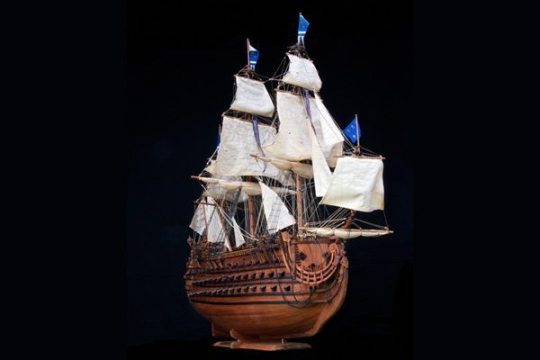
Modern Model of the Soleil Royal, 140- guns
The interest of the French in first rates was very low. This changed only with the reverses of the seven-year war which led to the French navy reviving its interest. And then it was one of the first ships which fall into the hands of the Royal Navy, the Ville de Paris, 104 guns. She was the flagship of Vice-Admiral Comte de Grasse who was captured with her at the Battle of Saintes in 1782. Her new captain was George Wilkinson and took her straight into service in the Caribbean. She was just on her way home, five months later, when she got into a Huricane and sank with rat and men, only one survived.
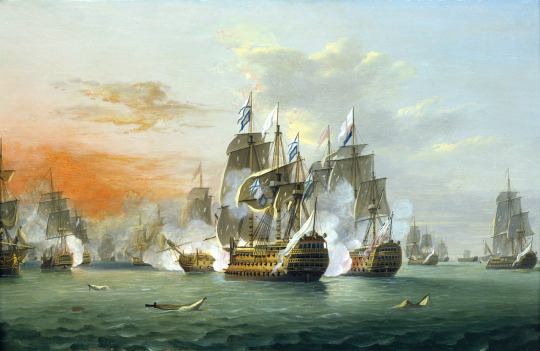
The Ville de Paris ,104- guns flagship of de Grasse, is fully seen in the centre on the left. Admiral Sir George Rodney, in the Formidable, 90- guns is engaging her to starboard on the right
It would take 11 years until the next first rate managed to get into the fangs of the Royal Navy. In August 1793 the Commerce de Marsaille, 120- guns, was caught before Toulon and in December it was brought to England. There it was re-equipped and put into service with fewer men (875) than it was the case with the French, but by the English canons which she carried now she did not need the enormous number of 1098 men any more. But also her fate was not really a good one and as she should be used as a huge troop transporter she sank during a storm. Also her sister ship (first Dauphin Royal, then Sans Culotte, and finally Orient) blew up during the Battle of the Nile in 1798.
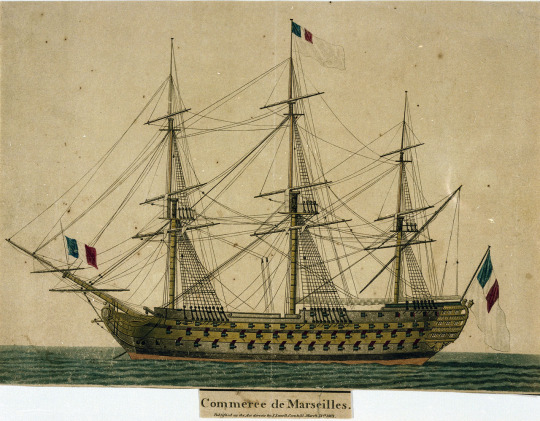
The Commerce de Marsaille, 120- guns
There the British had more luck with the Spaniards. These had begun in the years 1779 - 1794 with first, three three-deckers and had extended this then by seven further. So Admiral Sir John Jarvis was confronted with seven of them when Admiral Don José de Córdoba y Ramos with his 36 ships came to Cape St. Vincent, 1797, to put Jarvis. Even if the British were far inferior with their 22 ships, they managed to catch two first rates, the San Josef, 112-guns, and the Salvador del Mundo, 112- guns. Salvador de Mundo was accepted into the Royal Navy under her own name and subsequently served in port service during the rest of the French Revolutionary Wars and the subsequent Napoleonic Wars. At the end of the wars, when she was decommissioned and broken up.
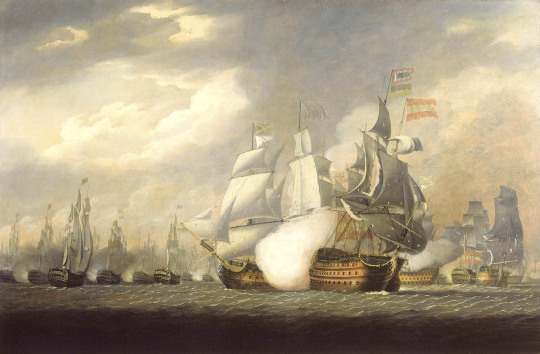
The Victory Raking the Spanish Salvador del Mundo at the Battle of Cape St Vincent, 14 February, 1797
The San Josef was also in service and was in the active service until 1807 when she was taken out and used from 1837 as a gunnery training ship. From 10 August 1841 she was commanded by Captain Joseph Needham Tayler, serving as a guard ship at Devonport (established gunnery school). Other captains who served in her include: Captain Frederick William Burgoyne, while serving as the flagship of Samuel Pym, Plymouth; Captain Henry John Leeke; and Captain Thomas Maitland, as the flagship of Admiral William Hall Gage, Devonport. She was broken up a Devonport in May 1849.
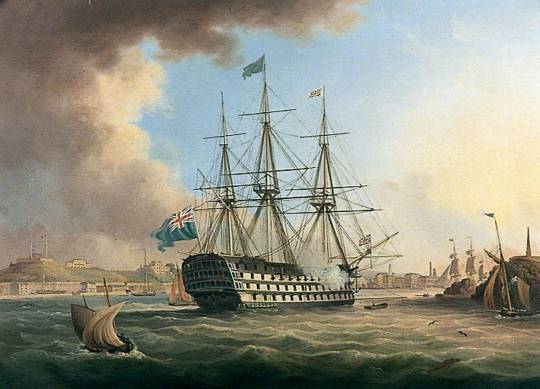
HMS San Josef, 112- guns, as a gunnery training ship
In 1801 the Real Charlos and San Hermenegildo, both with 112 guns, were destroyed off Gibraltar. At the Battle of Trafalgar 1805, the Santissima Trinidad, once the pride of the Spanish Navy with 130 guns, was destroyed.
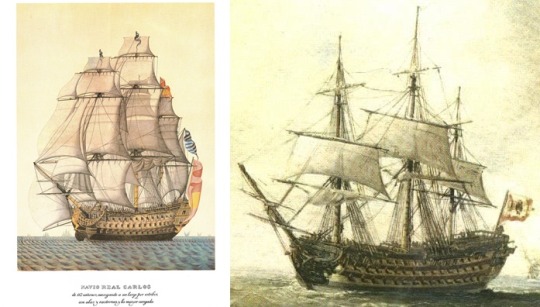
Real Charlos ( left) and the San Hermenegildo (right), both with 112- guns
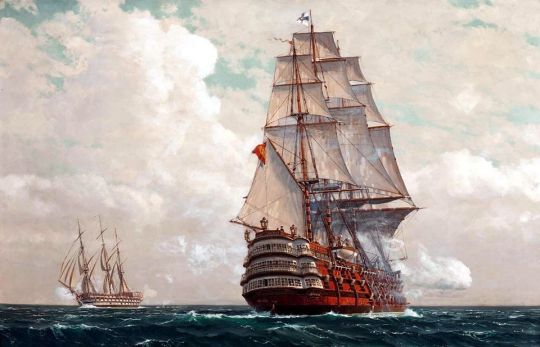
The Santissima Trinidad, 130- guns
The last enemy three decker that was destroyed was the Impérial, 118 guns. She was built as Vengeur in 1804 and then renamed. However, she ran aground during the Battle of San Domingo in 1806, and was destroyed in the process.
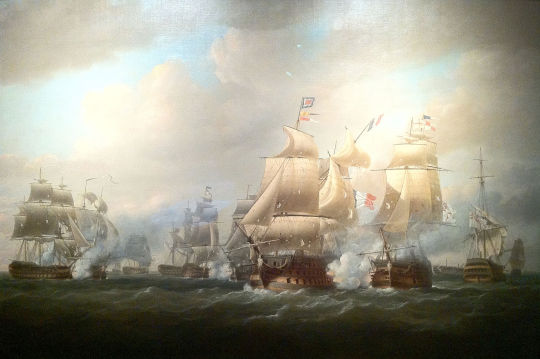
The Battle of San Domingo 1806 : Impérial harassed by the much weaker HMS Northumberland before being driven ashore
118 notes
·
View notes
Photo
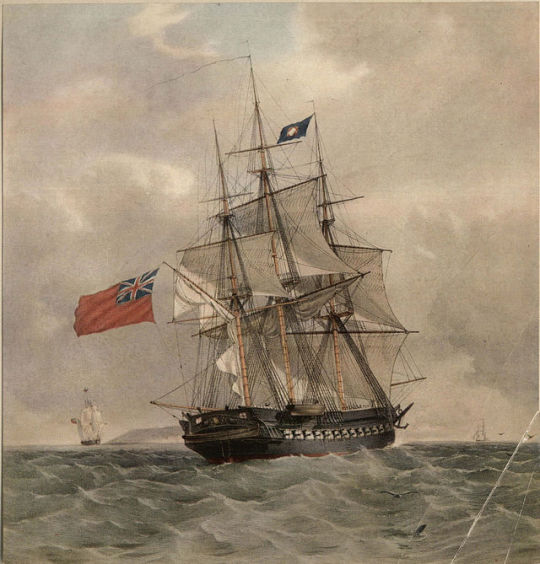
HMS Pomone 1805, Color lithograph by T. G. Dutton after painting by G.F. St. John (c) Macpherson collection in, Alan Moore, Sir, Bt. (1926) Sailing Ships of War, 1800-1860
The Pomone was a fifth range frigate with nominal 38 guns and belonged to the very successful Leda class. Right after its completion it had actually been assigned for canal service, but it managed to capture two prizes in Spanish waters. In the years 1806/7 she even managed to capture or sink 21 French ships under her new Captain Sir Robert Barrie.
On October 21, 1809, the ships Pomone and Alceste were ordered to observe the French naval base Toulon and to determine possible enemy movements. Barrie could now observe how a French part of the fleet in the form of a squadron was getting ready to sail. He immediately sailed to the Golfe du Lion to meet Admiral Lord Collingwood, who was there on his 110-cannon flagship Ville de Paris to report to him on the events. Collingwood and a British squadron took up the pursuit. Back in sight of the French squadron, the Pomone successfully fought five ships belonging to the French convoy before the rest of the convoy lost itself in the dark.
Rear Admiral George Martin was able to resume the squadron the next day on the south coast of France and continued the pursuit. Some French ships obviously came under so much pressure that the Lion and the Robust stranded at the level of the port city of Frontignan. So that the ships did not fall into British hands, after two hours of futile liberation efforts, their burning was finally ordered. The following years she was also very successful and made some prizes. Among them was a ship on which Lucien Bonaparte, his family and some followers stayed. Captain Barrie then took him to the British occupied island of Malta, which he reached on 23 August 1810, together with a total of 40 other people.
On 13 March 1811 the Pomone was located between Corsica and Sardinia when it took up the pursuit of the 16 gun brig Etourdie. It was not until 14 March that the Etourdie was able to catch up, so that the crew of the Etourdie set fire to their own ship on the island of Montecristo in order not to be captured or even taken as a prize. Around 3 p.m. of the same day, the French ship finally exploded due to the progressing fire.
On April 30, 1811, the Pomone, together with the frigate Unite, reached Sagone Bay, Corsica, after reports of a collection of enemy ships in this area. The next day, the British Brigg-Sloop Scout joined in and three enemy ships protected by a coastal battery were finally encountered: The 26-cannon giraffe, the 14-cannon Nourrice and an armed merchant ship.
As the weather was calm, the British captains rowed their ships with the dinghies within firing range and heavily fired at the French warships and land defences. After about one and a half hours of battle, the destroyed coastal battery had to stop fighting and the French ships finally caught fire. It is suspected that the fires on board the French ships were also due to the destruction of a Genoese coastguard tower of the coastal battery, as the ammunition store was also hit and destroyed. The British then rowed at a safe distance from the burning ships before they also exploded. The Pomone had two dead and 19 wounded to mourn, while the Scout and the Unite had to register only six wounded. The mission had thus been successfully completed.
On October 14, 1811 it was on its way back from the Mediterranean Sea to its home waters for some repairs. On board at this time was Sir Harford Jones, the British ambassador of Persia as well as some Arab stallions, which should be a gift from the Shah of Persia to king George III. At 7 o'clock the ship hit the rocks of "The Needles" of the Isle of Wight, because the Master James Sturrock confused the lighthouse of The Needles with the lighthouse of Hurst Castle. The Pomone came into contact with an underwater rock southwest of Needles Point. The crew tried to save the ship by cutting the masts, but couldn't get it free anymore. Due to the lucky circumstance that there was hardly any wind, auxiliary ships were able to come within an hour and save the entire crew. Over the next three days, masts, cannons, cargo and even the Shah's horses could be salvaged.
A trial convened on October 25 cleared Barrie and his officers of all guilt, but Master James Sturrock disciplined him for his faulty navigation.Barrie was then transferred to Dragon, a third-rate, 74 - guns.As a result of the accident, the Admiralty of the Royal Navy ordered that night-time voyages near The Needles should be avoided.
Interesting fact: At the wreck site of The Needles in 1969 the remains of two shipwrecks were found: On the one hand from the Pomone and from the Assurance which had accumulated at the same place in 1753. The wreck site is subject to the "Protection of Wrecks Act" of 4 April 1974, a decision of the United Kingdom government to protect shipwrecks from unauthorised access and plunder. In today's Underwater Archaeology Centre in Fort Victoria on the Isle of Wight, the museum there also partly deals with the wreck of the Pomone. So far, more than 3000 artefacts have been recovered and evaluated with official permission.
#naval art#hms pomone#sorry her history is a bit long#but damn she was a little sea bitch#1805-1811#age of sail
150 notes
·
View notes
Photo

Assault and capture of the French corvette La Chevrette by HMS Doris, 21 July 1801, by John Christian Schetky
HMS Doris was in company with the 40 gun frigate HMS Beaulieu, when they spotted the French 20 gun ship-corvette Chevrette lying under a shore battery in Camaret Bay. The French considered that given the strength of the shore battery, that the Chevrette was a secure as she would be if she was in the harbour at Brest. Nevertheless, Captain Brisbane resolved that the French vessel would be taken, despite the difficulties and the risk. His reputation had gone before him, so when he called for volunteers for the mission, there was no shortage. The mission was to be commanded by Lieutenant Woodley Losack, who had been sent from the Channel Fleet's flagship, the mighty HMS Ville de Paris of 110 guns, specifically to command the mission. On the night of 20th July, the force comprising of all the boats from HMS Doris and HMS Beaulieu, set off. Things went wrong when the boats became separated as a result of the lead boats pulling ahead. The rear-most boats decided to return to the ships when they lost sight of the others in the darkness. The lead boats meanwhile reached the entrance to Camaret Bay, where they lay at their oars waiting for the others to catch up. When they had failed to arrive by daybreak on the 21st, since the operation needed to be conducted in darkness, the leading boats also decided to return to the ships.
Unfortunately, they had been spotted by the French and although they had not been fired upon by the enemy, the French decided to lay a trap for the British in case they decided to try again. La Chevrette weighed anchor and sailed about a mile and a half further into the bay. There, the French crew was reinforced by soldiers, bringing to 339 the total number of men aboard. In addition, La Chevrette was now moored under a larger, more heavily armed shore battery. The shore battery itself was augmented by the throwing up of temporary earthworks. Arms and ammunition were brought on deck and the ship's guns were loaded almost to their muzzles with grapeshot. The French moored a guardboat, fitted with 2 36pdr long guns at the entrance to the bay and to encourage the British to try to attack them again, hoisted French colours over British ones. This was seen by the British frigates, which by now had been joined by a third ship, the ex-French 38 gun frigate HMS Uranie. It had the desired effect and the British were determined to capture La Chevrette.
During the 21st July, the force was joined by the pinnace and barge from HMS Robust (74), bringing the total number of boats to 15 and the total number of British officers and men committed to the attack to about 280. At about 21:30, the British launched a second attempt, again commanded by Lieutenant Losack. Shortly after they departed from the frigate position, Lieutenant Losack took his own and five other boats to chase down an enemy boat, presumed to be the lookout boat posted by the enemy to watch for their approach. This was the right and proper thing to do; the British had already lost the element of surprise. The remaining boats pulled slowly ahead or lay on their oars waiting for their commander to return. When he did not return as soon as expected, command of the mission devolved to Lieutenant Keith Maxwell of HMS Beaulieu and he, mindful of the advancing time and the six miles they had to go to reach the enemy vessel, ordered that they pull ahead regardless. By now, the force had been reduced by a third, so Lieutenant Maxwell issued new orders, redeploying his men to make better use of the reduced resources now available to him. At about 01:00 on the 22nd July, the force sighted La Chevrette, which opened fire with grapeshot and muskets. They were joined in this by musket fire from ashore. The British then rushed at the enemy ship. HMS Beaulieu's boats under Lieutenant Maxwell assisted by Lieutenant James Pasley and Royal Marine Lieutenant James Sinclair attacked La Chevrette;s starboard bow and quarter.
One of HMS Uranie's boats commanded by Lieutenant Martin Neville, one of HMS Robust's boats commanded by Mr Midshipman Robert Warren and one of HMS Doris' boats commanded by Lieutenant Walter Burke attacked the port bow. The attack was met with fierce resistance from the French, armed as they were with muskets, pistols, tomahawks, pikes and swords. The French attempted to board the boats. In the face of brutal hand-to-hand fighting in which no quarter was asked or given, the British sailors, marines and officers had to literally hack their way through the mass of French sailors and soldiers to reach their objectives. Despite being outnumbered three to one, the British quickly took control of the French ship's yards and within three minutes of getting aboard La Chevrette, had released all three topsails and cut the anchor cable. As soon as they saw their ship getting underway, many of the enemy jumped overboard while others threw down their weapons and fled below. This enable the British to gain control of the quarterdeck and forecastle. By this point, almost five minutes had elapsed since the British had first boarded the French vessel and her decks were covered with dead bodies and her scuppers were running with the blood of the dead and wounded. For a while, some of the enemy continued firing their muskets through the hatches, but they were soon overwhelmed by the British and forced to surrender. As they sailed their prize out of the bay, the British were fired upon from the batteries ashore, but to no avail. They had done it.
They had overwhelmed a force three times their own number and had stolen a fully armed and manned French warship from under the guns of a powerful shore battery. This did not come without a cost however. Royal Marine Lieutenant James Sinclair and Midshipman Warren together with seven seamen and two marines had been killed. Lieutenants Martin Neville and Walter Burke together with Masters Mate Mr William Phillips, Midshipmen Edward Crofton, Edward Byrn and Robert Finnis together with 42 seamen and 9 marines were wounded. Lieutenant Burke of HMS Doris died of his wounds later. La Chevrette's loss had been far greater. In ten minutes of frenzied fighting, 92 Frenchmen had been killed and 62 wounded. The dead included her captain, two of her three lieutenants, an army officer and three midshipmen.
23 notes
·
View notes